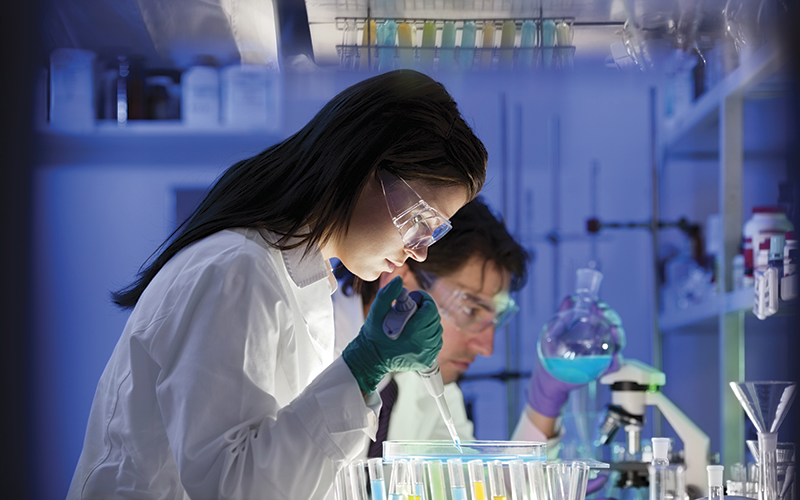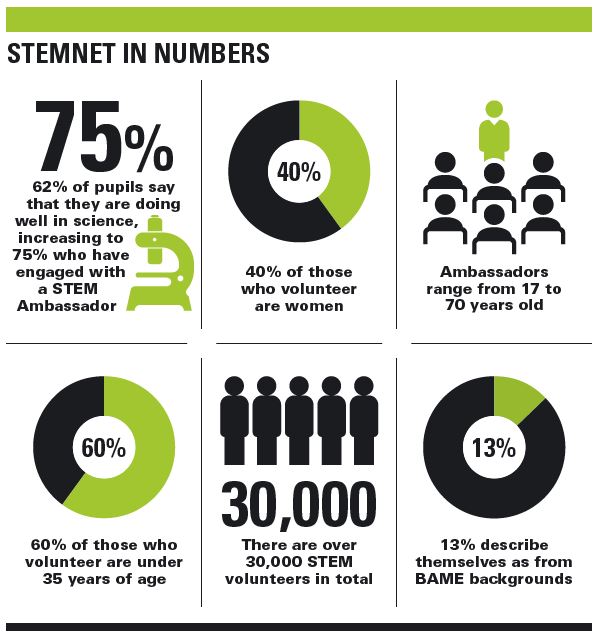Michael Liveley, a Biomedical Scientist from Addenbrooke’s Hospital in Cambridge, discusses his work as a STEM Ambassador.

My journey as a STEM (science, technology, engineering and mathematics) Ambassador began when a biomedical scientist came to the school to speak about his role within a pathology laboratory. I had always wanted to do something with science and after hearing his talk I thought “I could do that”. Fast-forward a few years and I was a newly qualified Biomedical Scientist.
The training officer saw my enthusiasm and put me in touch with the team at STEMNET – a network of volunteers, aiming to inspire young people to follow a STEM career. Since volunteering, I’ve taken part in various different activities, including classroom demonstrations, careers events and laboratory tours. I’ve spoken to children of primary school age right up to university students.
One thing that often strikes me is the maturity and thoughtful questions I’m asked about my job – showing me that the students have really engaged with what I’ve spoken about. One young student told me she’d like to pursue a career as a forensic scientist, this was undoubtedly due to the popularity of TV shows such as CSI – but, nevertheless, it reminded me that many youngsters are considering where they would like to be in the future and the importance of giving them the information to get there.
Science in action
My favourite events are when I get to show science in action. This may be something as simple as looking down a microscope or an analytical test on a fake sample – I find this a great way to bring the laboratory into a classroom and make science relevant. Although I can’t replicate exactly what I do in an immunology laboratory, I can show the sort of work that biomedical scientists do.
One simple experiment involved making fake urine samples (tap water and yellow food colouring). Into one sample I crushed up a glucose tablet. Some urine dipsticks allowed students to find the “patient” with sugar in their urine.
This then led into a short talk about diabetes along with different methods to diagnose and monitor the condition. I also enjoy attending careers events, especially when multiple schools attend and I’ve assisted with stalls at various places, including the National Space Centre in Leicester and Ely Cathedral.
Attending large careers events is always lots of fun with plenty of students keen to talk and discuss the options open to them. The atmosphere is always one of immense interest and students leave with a greater understanding of possible career choices.
TOP TIPS:
✔ Photos and props always make talks more interesting
✔ Bright and eye-catching posters are useful for getting noticed and starting conversations
✔ Get feedback after events from teachers and organisers to improve subsequent talks
✔ Enjoy yourself – students will respond well if you have a positive attitude.
Public profile
Being an Ambassador is also a great opportunity to raise the profile of biomedical science, since many people have no idea what goes on within a typical pathology laboratory. Biomedical scientists are often described as the “unseen healthcare providers” – the public may not see us but millions of analytical tests are carried out each year and many diseases simply could not be diagnosed without someone in a white coat playing their part.
The most memorable presentation I’ve given was at my old secondary school. It was strange returning to the school as a guest speaker. I was able to relate to the students because not so long ago I was sitting in the same classroom.
I was even mentioned in the local paper after the event – something a little different for the CPD folder.
Time and commitment
One of the great things about being a STEM Ambassador is that you have control over the amount of time you put in. STEMNET just ask that you participate in at least one event per year. Some of the events I’ve assisted with have been simple classroom talks lasting less than an hour, others events have lasted the whole day.
Ambassadors receive regular emails from the local branch of STEMNET requesting assistance with various different activities, including classroom talks, mentoring opportunities, practical demonstrations, career days, competition judging, after school clubs and so on.
The types of events are almost endless, anything to help inspire young people to follow a career in a STEM subject will count. You can also record activities organised through your place of work, such as open days or laboratory tours.
Personal development
Finally, being a STEM Ambassador has been useful for my own personal development. Not only does it count towards CPD, it has also helped improve my confidence, especially when giving presentations. I’ve learnt to explain scientific concepts to students of all ages and abilities. Some elements of my presentations have worked better than others, so I’m constantly learning and striving to improve.
Volunteering as an Ambassador has allowed me to meet some great people, visit interesting places and hopefully I have made a positive impact on the lives of many young people.
If this sounds like something you’d enjoy, I’d recommend becoming an Ambassador and sharing your experiences with the next generation.
For information on volunteering, visit stemnet.org.uk

